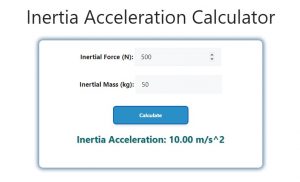About Inertia Acceleration Calculator (Formula)
Inertia acceleration refers to the rate at which an object’s velocity changes due to its inertial force. It’s a fundamental concept in physics, particularly when dealing with Newton’s laws of motion. The Inertia Acceleration Calculator helps you calculate the acceleration of an object based on its inertial force and mass. This is an essential tool for engineers, physicists, and anyone working in mechanical systems.
Formula
The formula for calculating inertia acceleration is:
Inertia Acceleration = Inertial Force / Inertial Mass.
Where:
- Inertial Force is the force acting on the object due to inertia.
- Inertial Mass is the mass of the object.
How to Use
To use the Inertia Acceleration Calculator:
- Enter the inertial force acting on the object in Newtons (N).
- Input the inertial mass of the object in kilograms (kg).
- Press the “Calculate” button to determine the inertia acceleration.
Example
Let’s calculate the inertia acceleration for an object with an inertial force of 500 N and an inertial mass of 50 kg.
Using the formula:
Inertia Acceleration = 500 N / 50 kg = 10 m/s².
So, the inertia acceleration of the object is 10 meters per second squared.

FAQs
- What is inertia acceleration?
Inertia acceleration is the acceleration an object experiences due to the inertial force acting upon it. - How does inertial force affect acceleration?
The greater the inertial force, the higher the acceleration, provided the mass remains constant. - What unit is inertia acceleration measured in?
It is measured in meters per second squared (m/s²). - What is inertial mass?
Inertial mass refers to the mass of an object as it resists acceleration due to an applied force. - Can the calculator be used for rotational inertia?
No, this calculator is designed for linear inertia acceleration. Rotational inertia would require a different formula. - What is the difference between inertial force and gravitational force?
Inertial force is the force resisting a change in motion, while gravitational force is the attraction between masses due to gravity. - Is inertia the same as mass?
No, inertia refers to the resistance of an object to a change in motion, whereas mass is a measure of the amount of matter in an object. - Can this formula be used for objects in space?
Yes, inertia acceleration can be calculated for objects in space as long as you know the inertial force and mass. - What happens if the inertial mass is zero?
In reality, inertial mass cannot be zero. If it were, the object would not resist any force, which contradicts physical laws. - Can inertial force be negative?
Yes, inertial force can be negative, which indicates the direction of the force is opposite to the direction of motion. - What is the relation between inertial mass and acceleration?
The greater the inertial mass, the less acceleration the object will experience under the same force. - How is this formula related to Newton’s Second Law?
This formula is derived from Newton’s Second Law, which states that force equals mass times acceleration (F = ma). - Is the calculator accurate for all objects?
Yes, the calculator will provide accurate results as long as you input the correct values for inertial force and mass. - Can this calculator be used for vehicles?
Yes, the formula can be applied to calculate the inertia acceleration of vehicles when you know their inertial force and mass. - Why is inertia important in physics?
Inertia is crucial in understanding how objects respond to forces and resist changes in their motion. - Can an object have zero inertia?
No, all objects with mass have inertia, which resists changes to their motion. - How is this related to everyday objects?
Any object that experiences a change in motion, such as a car accelerating or a ball being thrown, involves inertia acceleration. - What’s the difference between inertial mass and weight?
Inertial mass is the property of matter that resists acceleration, while weight is the force exerted by gravity on an object. - How does velocity affect inertia acceleration?
Velocity does not directly affect inertia acceleration. Acceleration depends on the force and mass, not on velocity. - What happens if there is no inertial force?
If there is no inertial force, the object will not experience any acceleration and will remain at rest or in constant motion.
Conclusion
The Inertia Acceleration Calculator is a practical tool for calculating how an object’s velocity changes under the influence of an inertial force. By understanding the relationship between inertial force and mass, you can easily determine the inertia acceleration of any object. This calculator simplifies the process, making it useful for various applications in physics and engineering.